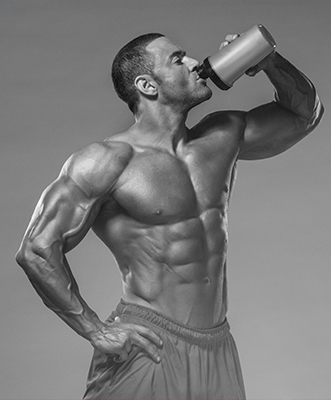Blog
The Ultimate Lean Bulking Diet Guide
You’ll need a lean bulking diet to build muscle and fill out the way you want to. We’ll show you how to make that happen.

Tired of feeling scrawny and wish you could put on some muscle? If you’re looking to fill out your t-shirt arm sleeves or make your booty pop in a new pair of jeans, then it might be time for you to start a lean bulking diet.
We’ll walk you through what to do from both a diet and training perspective to build muscle fast and put on the size you want.
What Does Bulking Mean?
In the bodybuilding or fitness world, you might’ve heard people say they’re starting a bulk. That’s when your primary goal becomes building muscle while keeping fat gain to a minimum. It involves eating more than you normally would and using those extra calories to train hard at home or in the gym.
If strength training is a new thing for you, then you might benefit from “newbie gains” and be able to build muscle and burn fat at the same time. But if you’ve been working out for a little bit, it can be hard to do both. So you’ll probably get the best results by going on a bulking and cutting cycle.
When you’re bulking, the goal is to build muscle while minimizing fat gain. On the flip side of that, cutting is when you’re looking to lean out and burn fat (which inevitably means you’ll lose a little muscle). A simple way to think about it is like this: bulking = muscle; cutting = fat loss.
Typically, you’ll go on a bulking phase for about 4-6 months, then follow that up with a cutting phase of about 3-4 months to lean out and get beach-body ready in time for summer.
Lean Bulk vs. Dirty Bulk
Of course, you probably want to go with a lean bulk. While gaining at least a little fat may be unavoidable, starting a lean bulking diet instead of a dirty one (where you eat whatever you want) will help you build the most muscle without putting on too much fat.
How to Create a Bulking Diet Plan
When you’re in a bulking phase, you want to be in a caloric surplus. That means you’re taking in more calories than you’re burning off. The extra calories you consume will fuel greater muscle gains. You can create a caloric surplus by eating slightly more than you would normally (start with an increase of about 250-500 calories).
Counting macros is a simple way to hold yourself accountable and make sure you’re consistently in a caloric surplus. Luckily, you can figure out your own personal bulking macros in just 3 easy steps:
How to Figure Out Your Bulking Macros
Step 1: Use a calculator like this one here to determine your TDEE (total daily energy expenditure).
Step 2: Add 250-500 calories to your TDEE to get how many calories you should consume daily.
Step 3: Determine the amount of protein, carbs, and fats to eat.
Now, let’s walk through an example person so you can get the gist of how it looks.
Here are some stats for our example person:
- 29-year-old male
- 6’1’’
- 200 lbs
- Works out moderately
Using the TDEE calculator, you should get maintenance calories for our example person of 2,985. Add 250 calories to that amount to get their bulking calories (3,235). Next, you’re going to determine the breakdown of protein, carbs, and fats.
For beginners, 1 gram of protein per pound of bodyweight is a good place to start, so that would be 200 grams. Fats, you want to get in anywhere from 0.2-0.4 grams per pound of bodyweight. We’ll go on the higher end with 0.4 (80 grams). Last but certainly not least, we have carbs.
To figure out your carbs, we’ll use something called the “4-4-9 Rule.” This rule states that protein and carbs contain 4 calories per gram of food, while fats contain 9 calories per gram. With that rule in mind, we can find the total number of calories that will come from both protein (200 grams x 4 calories per gram = 800 calories) and fats (80 grams x 9 calories per gram = 720 calories).
To get your carb calories, subtract your calories from protein and fat:
- 3,235 - 800 - 720 = 1,715 / 4 = 429 grams.
Here are the final macros for our example person:
- Protein: 200 grams (800 calories)
- Carbs: 429 grams (1,715 calories)
- Fats: 80 grams (720 calories)
Keep in this is just a starting point. Macro-counting is all about experimenting. For example, you might have more energy on a higher carb, lower-fat diet. Or maybe a diet that’s higher in fats helps you feel more full. Play around with your macros and see what works best for you.
What to Eat During a Bulking Phase
You’ll want to center your lean bulking diet on the three main macros. Here’s a sample bulking meal plan shopping list:
- Lean sources of protein to ignite your muscle-building efforts and help with muscle recovery: chicken breast, white fish, egg whites, low-fat Greek yogurt, or seitan or tempeh if you’re on a plant-based diet.
- Complex carbs to replenish depleted glycogen stores and give you energy for your workouts: beans and lentils, quinoa, rice, sweet potatoes, whole-wheat pasta and cereals, fruits, vegetables.
- Healthy fats to help with vitamin and nutrient absorption in your body: avocados, olive oil, seeds (i.e. chia seeds or flax seeds), nuts (like almonds, walnuts, or macadamia nuts).
Meal Timing on a Bulk
Sometimes, eating enough can be hard on a bulk—especially for hardgainers who burn calories easily—or for ectomorphs, who are naturally skinny. If you struggle to pack on bulk, consider smaller, more frequent meals so it doesn’t feel like you’re having to down a buffet at each sitting. Or maybe you like intermittent fasting so you can eat larger meals. It really depends on your personal preference.
One thing that’s good for your budget and can save you loads of time is meal prepping. You’ll eat out less and your meals are likely to be healthier because they’re made at home.
How to Train for Bulking
The best way to build muscle without gaining too much fat is by following a workout program that focuses on progressive overload. Another thing you’ll want to do—which will maximize your workout time— is make sure you’re hitting all the compound lifts (think squats, bench press, and deadlift).
Your bulking workout split will vary depending on how much time you can commit to the gym each week. Don’t have a whole bunch of time? Go for total-body workout routines. If you’re more advanced, or you just prefer to focus on one body part at a time, you can go with a body part split and train each muscle individually.
Conclusion: Lean Bulking Diet
A lean bulking diet hinges on eating above your maintenance calories and training hard so you can build muscle. Counting macros can give you a systematic way of staying in a caloric surplus. And within that surplus, aim to eat a mix of lean protein, complex carbs, and healthy fats.
When it comes to training, focus on progressive overload. If you need workout ideas, check out these chest exercises or leg exercises!

About the Author:
Chad Richardson is a freelance writer from Cincinnati, OH. It’s actually been rumored that Chad came out of the womb doing bicep curls, so it should come as no surprise that he enjoys creating content to help others get in shape and live healthier lives. When he’s not in the gym impersonating Arnold Schwarzenegger, you can probably catch Chad at a local bar with some friends, frustrated with his hometown Red Legs’ inability to stay above 500 for a whole season. His philosophy on life? Take action starting TODAY on that thing you’ve been putting off...Not tomorrow, next week, or whenever you feel motivated...A small step might not seem like much right now, but even small steps add up to a mile eventually.
Website: Chad’s Business Website
LinkedIn: Chad’s LinkedIn
References:
https://academic.oup.com/nutritionreviews/article/76/4/243/4851715
https://study.com/academy/lesson/body-types-mesomorph-ectomorph-endomorph.html
Since 1978, Ironmaster has been designing innovative home gym solutions. Our Quick-Lock Adjustable Dumbbells and Super Bench Adjustable Weight Bench are customer favorites. Visit Ironmaster.com to see our full catalog of products. For additional assistance finding the right equipment for your own home gym, email our team at ContactUs@Ironmaster.com.
